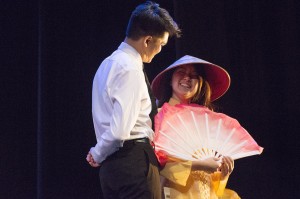As a child, Lyna Truong would ask her parents to tell her about their emigration from Vietnam during the war. They would always hesitate, refuse or brush off her requests.
They didn’t want their youngest daughter to hear about the scramble onto the cramped boat pushing off from the rough Vietnamese beach, setting off towards an uncertain destination. They didn’t want her to worry, to learn about the hardships they had worked hard to bury and leave behind.
Truong is now a fourth-year psychology student who has been involved in Vietnamese Culture Night since 2013. Over her time involved in the event, she said she was able to connect more with her culture and understand her parents’ hardships and the world her family comes from.
“I think I have become more empathetic with (my parents),” Truong said. “When we have arguments and such, it’s enabled me to stop the argument and think about their perspective.”
Last year’s VCN was centered around the 40th anniversary of the fall of Saigon and depicted the Vietnamese-American immigrant experience. After having spent the first two years in traditional dance, it was Truong’s first attempt at drama.
The performance, Truong said, was a way for her to reflect on her interpretation of her parents’ experiences. She played the youngest daughter of an immigrant family – a role that reflects her actual family situation.
“It wasn’t until her third year that I had seen her parents cry for the first time seeing the performance and seeing her being a representation of the Vietnamese immigrant story,” said Kevin Truong, her cousin, fellow traditional dance member and a fourth-year neuroscience student.
Teresa Cao, a fourth-year psychobiology student, traditional dance member and Lyna Truong’s best friend, said Truong was quite reserved when they met. Over time, Cao said Truong has become more open with other people.
When Truong switched to drama to get out of her comfort zone, she noticed the profound effect it had on her as a person. She said the role encouraged her to identify with her parents’ ordeal escaping from Vietnam and become more knowledgeable about the refugee experience.
“When she was speaking her lines, she was acting as if she was talking to her parents,” Cao said.
This year, the show was titled “See You Tomorrow – Lối Về Bình Yên,” and focused on mental health on college campuses by telling a story of depression seen through the Vietnamese-American student perspective.
Truong returned to traditional dance for her fourth and last VCN. Having gained many close friends in traditional dance over the years, she wanted to return to share the stage with them.
“I keep using the word ‘family’ because it’s true: In traditional (dance), we really are one big family,” Truong said.
After initially joining traditional dance her freshman year, she said she unexpectedly and immediately found the family she was looking for. Kevin Truong said she has also grown a great deal since freshman year, having matured emotionally and become more confident.
“She’s extended her repertoire of fields – she’s a dancer, she’s an actress,” Kevin Truong said. “She’s grown a lot since we were little kids.”
Lyna Truong said when she joined traditional dance, she looked up to the older members who were seniors at the time. Graduating this year, she said she has changed from being inspired by her seniors to being the person who inspires the new members.
In the future, she hopes to come back to VCN to watch the new shows and see how they evolve – after all, it shaped her college and cultural experience.
During the intermission, Truong clutched her goldenrod áo dài, a traditional Vietnamese outfit, as she rushed up the backstage stairs to meet her parents in the auditorium. Spotting them in the front, she embraced them tightly. Her father’s face, peeking over her shoulder, beamed with pride.
“It’s very empowering to be a part of something like that,” Truong said. “It’s a way for many of us to meet our elders in the middle – to learn about their perspective and their side but also educate them on what our generation is thinking as well.”
Contributing reports by Sarah Ahern, A&E contributor and Shreya Aiyar, A&E senior staff.
